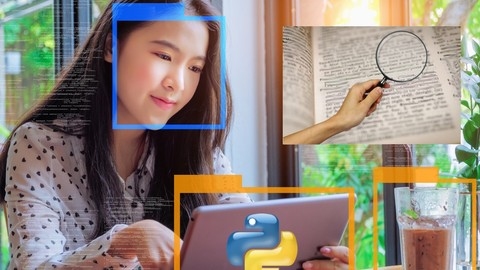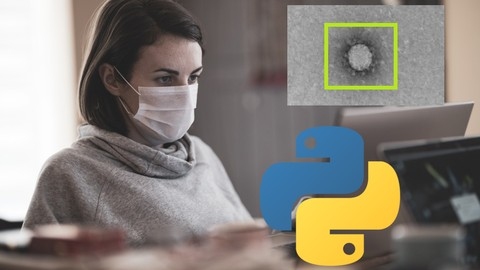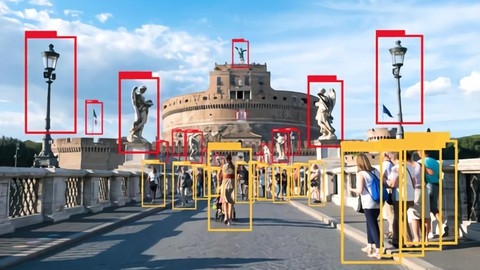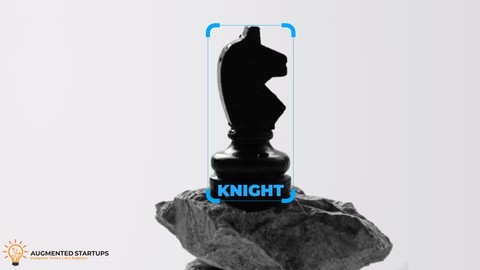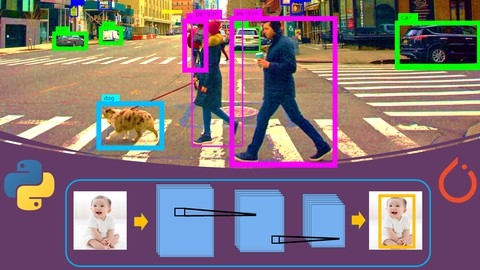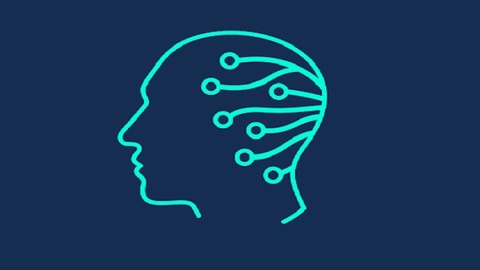Object detection is a fundamental area of computer vision, enabling machines to recognize and locate objects within images and videos.
It powers a wide range of applications, from self-driving cars and security systems to medical image analysis and retail analytics.
Learning object detection can open doors to exciting careers in AI and computer vision, allowing you to develop innovative solutions for real-world problems.
Finding the right object detection course on Udemy can be a challenge, with so many options available.
You’re likely searching for a course that goes beyond theory, offering practical experience and hands-on projects to solidify your understanding.
For the best object detection course overall on Udemy, we recommend Train YOLO for Object Detection with Custom Data.
This comprehensive course provides a deep dive into YOLO (You Only Look Once), one of the most popular object detection algorithms.
You’ll learn how to train YOLO models on custom datasets, enabling you to tackle specific object detection tasks tailored to your needs.
The course covers both theoretical concepts and practical implementation, guiding you through the entire process from data preparation to model deployment.
You’ll gain hands-on experience with tools like Darknet, OpenCV, and PyQt, equipping you with valuable skills for real-world computer vision projects.
Whether you’re a beginner or have some experience in machine learning, this course offers a structured path to mastering object detection with YOLO, making it an excellent choice for anyone looking to advance their skills in this exciting field.
While this is our top pick, other great options exist for different learning styles and goals.
Keep reading to explore our full list of recommendations and find the perfect object detection course for your journey.
Train YOLO for Object Detection with Custom Data
You’ll start by understanding the fundamentals, including simple object detection techniques like thresholding with masks.
The course then dives into the practical application of YOLO v3 and v4.
You’ll learn to perform object detection on images and videos, even in real-time, using libraries like OpenCV.
You’ll master essential tools like Miniconda, Python, and PyCharm, equipping you with the foundation for a successful machine learning career.
A crucial aspect of this course is its focus on data preparation and annotation.
You’ll learn to create custom datasets by labeling images and videos in the YOLO format, which is essential for training your own models.
This includes learning how to utilize tools for image download, file conversion, and data preparation.
You’ll even work with the Traffic Signs dataset, gaining experience in converting real-world data to a YOLO-compatible format.
Next, you’ll dive into the intricacies of training YOLO v3 and v4 within the Darknet framework.
You’ll gain hands-on experience installing and using Darknet, configuring training parameters, and monitoring the training process.
The course provides practical guidance for testing your trained models on both images and videos, allowing you to evaluate your model’s performance.
Building on this foundation, you’ll learn to create a PyQt user interface to integrate your YOLO model for real-world applications.
This experience will help you bridge the gap between theoretical knowledge and practical implementation.
The course concludes by introducing you to YOLO v4 and v5, highlighting their advancements and training techniques.
You’ll learn how to train these powerful algorithms using your own datasets, leveraging both CPU and GPU resources for faster processing.
You’ll be equipped to tackle challenges in image and video analysis, making you a valuable asset in the field of computer vision.
Computer Vision: Python OCR & Object Detection Quick Starter
You’ll start by setting up your development environment using Anaconda, a powerful tool for managing Python libraries, which will form the foundation for your computer vision projects.
The course then guides you through the essential basics of Python programming, equipping you with the language proficiency needed to effectively interact with computer vision tools.
Optical Character Recognition (OCR) is then introduced, demonstrating how to extract text from images using Tesseract, a powerful library with applications ranging from document analysis to understanding signage in images.
You’ll delve into the captivating world of Convolutional Neural Networks (CNNs) and learn how to leverage their power for image recognition.
The course covers a range of popular pre-trained models, including VGGNet, ResNet, Inception, and Xception, showcasing their applications in recognizing objects within images.
The course seamlessly transitions into the realm of object detection, exploring advanced models like MobileNet-SSD, Mask RCNN, and YOLO.
These powerful tools allow you to identify and locate objects within images and even videos, including real-time object detection using your webcam.
The course concludes with a discussion of YOLOv4, the latest version of the popular YOLO model, demonstrating its capabilities in object detection.
This course offers a solid foundation in computer vision, equipping you with practical skills in Python and popular libraries like OpenCV, Tesseract, and Keras.
While the course provides a strong introduction to the key concepts and tools, it’s important to note that it might not be suitable for those seeking in-depth exploration of specific models or advanced techniques.
For those seeking a deeper understanding of specific aspects of computer vision, exploring additional resources and specialized courses might be beneficial.
YOLOv8: Object Detection, Tracking & Web App in Python 2023
This course provides a comprehensive exploration of object detection and tracking using the powerful YOLOv8 algorithm.
You’ll embark on a journey from the fundamentals of object detection, exploring foundational concepts like Convolutional Neural Networks (CNNs) and architectures such as RCNN, Fast RCNN, Faster RCNN, and Mask R-CNN.
You’ll delve into the specifics of YOLOv8, comparing its capabilities to its predecessor, YOLOv7, particularly in tasks like license plate detection.
The course emphasizes practical implementation.
You’ll learn to set up and utilize YOLOv8 on your Windows machine and leverage the free online platform, Google Colab, for code execution.
A crucial aspect of the course is training your own custom YOLOv8 models, allowing you to adapt the algorithm to specific needs.
Imagine building a system to detect potholes in roads or ensuring workers wear safety gear in industrial environments – the possibilities are vast.
Moving beyond object detection, you’ll delve into object tracking, mastering the DeepSORT algorithm.
This will equip you to build systems capable of counting traffic, calculating vehicle speeds, and tracking the flow of vehicles entering and exiting specific areas.
But the journey doesn’t stop there.
You’ll also learn about object segmentation, allowing you to not only detect objects but also pinpoint their precise outlines.
This proves invaluable for tasks like segmenting cracks in roads or analyzing the boundaries of potholes.
The course culminates in the creation of a fully functional web app using YOLOv8 and Flask, a popular Python framework for web development.
Integrate this app with live webcams to achieve real-time object detection and tracking, enabling applications like automated traffic monitoring or real-time safety alerts.
The course concludes with a practical project where you build a system to detect and alert on Personal Protective Equipment (PPE) in real-time, showcasing the versatility of YOLOv8 in diverse scenarios.
You’ll gain hands-on experience working with YOLOv8, from its foundational principles to practical applications, preparing you to tackle real-world object detection and tracking challenges.
Computer Vision: YOLO Custom Object Detection with Colab GPU
Forget about relying on pre-trained models – you’ll learn to create your own!
You’ll start with the fundamentals of YOLO, diving into its core principles and how it works.
The course will then guide you through using a pre-trained YOLOv4 model to detect objects in images and videos, teaching you crucial concepts like Non-Maximum Suppression (NMS) for more accurate identification.
Then, it’s time to get your hands dirty with custom training!
This course takes you step-by-step through the entire process, from collecting your own dataset of images to labeling them using tools like LabelIM.
You’ll learn how to prepare your data for training and then master the Darknet framework, a key component of YOLOv4 training.
The course makes full use of Google Colab, a free online platform that allows you to leverage powerful GPU resources for significantly faster training times.
The course even features case studies exploring practical uses of this technology, like detecting Coronavirus in images and videos, showcasing its versatility across various fields.
If you’re ready to master the art of custom object detection, this course provides everything you need to get started and build cutting-edge solutions.
YOLO: Custom Object Detection & Web App in Python
You’ll embark on a journey that spans data collection and labeling, model training, and ultimately, the creation of a functional real-time object detection system.
The initial modules lay a strong foundation in object detection principles.
You’ll delve into the inner workings of YOLO, learning how to prepare your data for training, and gain hands-on experience with Python libraries like Pandas and OpenCV.
These modules guide you through the process of extracting information from images, manipulating data, and training your YOLO model using Google Colab.
You’ll explore strategies for fine-tuning the model for optimal performance.
The course then transitions into the exciting world of web application development using Streamlit.
This powerful Python library allows you to create interactive web apps with minimal code.
You’ll learn how to deploy your trained YOLO model to a web app, enhance its user interface with various widgets, and even integrate real-time object detection capabilities.
This enables you to create applications with a wide range of potential, from security systems and self-driving cars to advanced video games.
The course delivers a clear and practical approach to object detection and web application development, empowering you to build sophisticated systems using the YOLO framework.
YOLOv3 - Robust Deep Learning Object Detection in 1 hour
This course goes beyond the basics, equipping you with the knowledge and practical skills to build robust object detection models.
You’ll delve into the core concepts of deep learning, exploring convolutional neural networks and artificial neural networks.
The course then dives into the intricacies of the YOLOv3 architecture, explaining its strengths and how it surpasses other object detection algorithms in speed and accuracy.
A key advantage is the practical experience gained through the use of Supervisely, a robust platform for deep learning model training and deployment.
You’ll learn to scrape images, annotate datasets, and even leverage data augmentation to enhance model performance.
The course culminates in training your own YOLOv3 model from scratch and deploying it to real-world applications.
Beyond the technical aspects, you’ll gain valuable insights into the real-world applications of object detection through an interview with Ritesh Kanjee, an expert in extended reality (XR) development.
This bonus section provides a valuable perspective on how object detection is shaping the future of XR.
While the course provides a strong foundation in YOLOv3 and practical skills, you might find that it relies heavily on Supervisely, which may limit the ability to apply learned concepts to other platforms.
Additionally, the focus on practical implementation could benefit from more in-depth theoretical explanations for those seeking a deeper understanding of the underlying principles.
Ultimately, this course serves as a solid foundation for anyone eager to dive into the world of object detection using YOLOv3.
It offers a blend of theoretical knowledge and practical skills, but its reliance on Supervisely and emphasis on practical implementation may not be ideal for all learners.
Deep Learning for Object Detection with Python and PyTorch
This course is your deep dive into the world of object detection, powered by Python and PyTorch.
You’ll gain a comprehensive understanding of popular deep learning architectures like RCNN and YOLO, learning to pinpoint objects within images and videos with precision.
Prepare for a hands-on experience where you’ll master Google Colab, a cloud-based coding platform that will become your trusted companion throughout the course.
You’ll start with the fundamentals, exploring the concepts of single-stage and two-stage object detection before diving into the intricacies of different RCNN architectures, including Fast RCNN, Faster RCNN, and Mask RCNN.
These powerful tools will empower you to perform both object detection and instance segmentation, enabling you to identify objects and their precise boundaries.
You’ll also gain expertise in using Detectron2, a PyTorch library specifically designed for object detection.
The course then takes you from theory to real-world application by focusing on real-time object detection using YOLOv8.
You’ll learn how to train, evaluate, and deploy these models for tasks like video object detection, giving you the skills to create a custom dataset for object detection and fine-tune YOLOv8’s hyperparameters to achieve optimal performance.
To solidify your learning, you’ll work through complete code examples and gain access to a custom dataset.
The course also features bonus lectures on image and video segmentation and classification using Python.
Computer Vision - Object Detection on Videos - Deep Learning
This course takes a deep dive into the world of object detection in videos, utilizing the power of deep learning.
You’ll start by gaining a solid understanding of video architecture and its various use cases, laying a strong foundation for the journey ahead.
Get ready to explore the exciting realm of video analytics, learning about its architecture and how it’s used in real-world applications like security systems and traffic monitoring.
You’ll then dive into the practical aspects of video processing, mastering how to manipulate video files using codecs and employing various methods for capturing, saving, and reading video data.
The course then delves into the exciting field of object detection, starting with human detection using Euclidean distance.
You’ll be introduced to a range of popular object detection models, including Haar Cascade, HOG, Faster RCNN, R-FCN, SSD, and YOLO.
You’ll learn the intricacies of these models and get hands-on experience implementing them using OpenCV and Python, further enhanced by learning how to leverage the powerful PyCharm IDE.
Next, you’ll embark on a journey into the world of deep learning, learning to train your own image classification models using Google Colab.
You’ll explore the Inception V3 model, a powerful convolutional neural network, and discover how transfer learning can be used to tailor it to your specific tasks.
This skill will empower you to build valuable applications like face mask detection, a crucial technology in today’s world.
Finally, you’ll be introduced to the SORT framework, a popular algorithm for object tracking.
This technique allows you to track objects across frames in a video, enabling you to build applications that analyze movement and behavior.
You’ll even see a practical example of tracking people in a video, showcasing the power of this technique.


